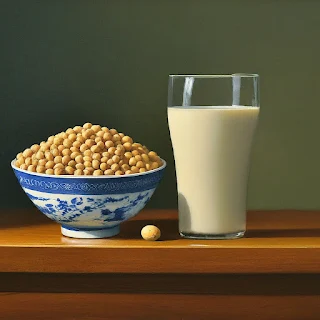Did you know there's a milk that skips the moo? Soy milk, a creamy concoction made from soybeans, has been a staple in Asian cuisine for centuries. But it's only recently become a superstar in kitchens around the world. This plant-based powerhouse offers a unique flavor and a surprising amount of versatility. Whether you're lactose intolerant, vegan, or simply looking for a healthy alternative, soy milk is worth a sip (or a gurgle, if you're pouring it into cereal).
When was soy Milk introduced?
Soy milk has a long and interesting history! While there's no single "introduction" date, we can pinpoint some key moments:
*Ancient China:*
The earliest evidence comes from China, with records of soy milk production dating back to the Han Dynasty (206 BCE – 220 CE). Back then, it was likely a thicker, soup-like drink.
*17th Century Europe:*
European explorers encountered soy milk in China and documented it in their writings.
*19th Century West:*
Soy milk finally reached the West in the 1800s, with the first mention in the US appearing in an 1897 report. The first commercial production in the US followed in 1917.
So, while soy milk has been around for centuries in Asia, it's a more recent arrival in Western countries.
Who invented soy milk in India?
There's no record of a single inventor for soy milk in India. Soybeans themselves were likely introduced to India centuries ago, but soy milk wasn't a traditional beverage there.
Historical records suggest commercial soy milk production in India is a fairly recent development:
* The first dedicated soy milk facility seems to be the one opened by Seventh-day Adventists in 1972.
When was soy first eaten?
Evidence suggests soy was first eaten in *northern China* around a remarkably long time ago: *as early as the 11th century BC*. That puts it at over 3,000 years ago!
Back then, the Chinese cultivated the wild soybean plant and likely valued it more for its benefits to the soil than as a direct food source. Over time, they developed the soybean into the food we know today.
What was soy originally used for?
Although soybeans have become incredibly versatile, their original use likely wasn't for food at all! Here are the two main contenders for soy's earliest purpose:
1. *Soil Improvement:*
Due to their unique ability to fix nitrogen in the soil, soybeans were likely first cultivated for their agricultural benefits. Nitrogen is essential for plant growth, and soybeans can capture atmospheric nitrogen and convert it into a usable form for other plants. By rotating soybeans with other crops, early farmers could improve the overall fertility of their land.
2. *Animal Feed:*
There's evidence that soybeans were also used as a food source, but likely for livestock rather than humans. Their high protein content makes them a nutritious option for animal feed.
When did soy become popular in Asia?
Soy became popular in Asia gradually over a long period, not with a single defining moment. Here's a breakdown of its journey:
*1100 BC (estimate):*
Domestication of soybeans in **northern China**. Initially, their value was likely for soil improvement through nitrogen fixation.
*200 BC – 220 CE (Han Dynasty):*
Evidence points to soy milk production in China during this period. Back then, it might have been a thicker, soup-like drink.
*1st Century AD:*
Soybeans spread from China to *Korea and Japan*.
*Over Centuries:*
Over time, various fermented and non-fermented soy products like tofu, tempeh, miso, and soy sauce were developed and became staples in Asian cuisine.
While there's no single "popularization" date, soybeans and soy products clearly became well-established in Asian diets by the Middle Ages.
Source 😀 Gemini


Comments
Post a Comment